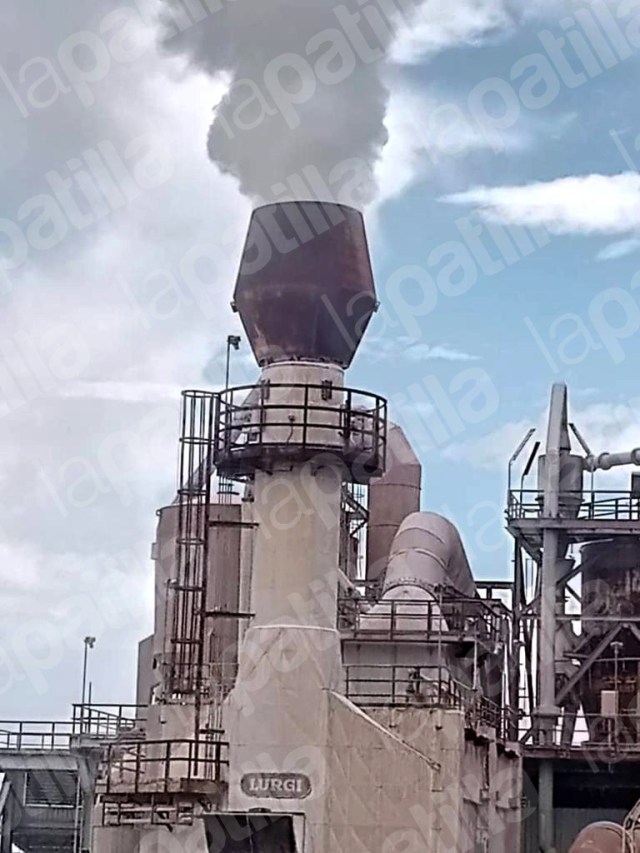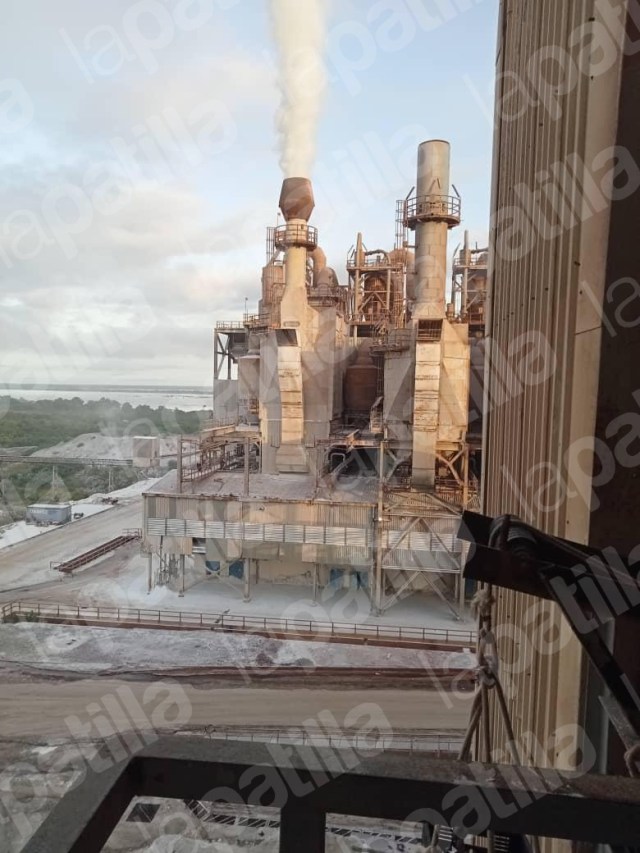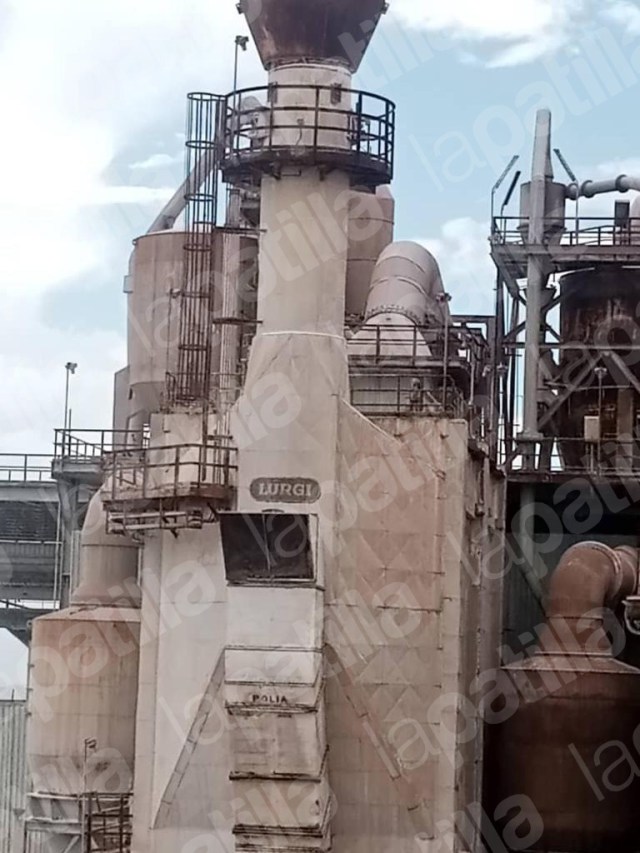
A very large smoking chimney can be seen from some neighborhoods of Puerto Ordaz. The ground in the surrounding areas is completely white, and if we were in another part of the world, anyone would think it was snow, but reality is far from that.
Pableysa Ostos // Correspondent lapatilla.com
That dust has covered not only the roofs and surrounding areas of ‘CVG Bauxilum’, but has also blanketed the avenues of Ciudad Guayana, as well as seeped into the houses of more than 200 families. That white powder is calcined alumina a substance that affects the health of the neighbors and also of the workers of that state company. The emission of this macabre dust intensified since September 4th, and it was only four days later, on September 8th, that the company issued a statement. Since then, the silence has been thunderous.
An employee of the company, who has been working for a long time in the area of calcination, described the current situation in the company as “something serious with the operation of calciners.”
“A few weeks ago a calciner was started up in conditions that were not at all suitable for processing alumina. A series of studies had been done on this calciner and the start-up method was not really done by the technical personnel who know about these operations. In addition to that, the team does not have the appropriate structures and equipment to prevent part of the alumina from being emitted into the atmosphere and thus into the population,” explained an employee who preferred to keep his name anonymous.
He pointed out that for months, and in order to not stop the plant’s operations, the hydrate began to be recirculated, which is a part of the alumina residue when the process is not completed. “They take it back to the initial process, such as the ball mills, and there that process starts again, but not with bauxite ore as it should be. What has been created at the end of the process is a kind of mixture that during calcination is too fine: the alumina and part of that alumina that is being transferred or processed towards Venalum, is spilled to the environment”.
Faulty Calciner

The worker added that the calciner was activated a month ago and was stopped again for three days to try to start another calciner, but the start-up procedures for that other calciner were not done with the required steps and part of the internal refractory exploded, because there was no adequate preheating and there was a faulty boot process.
“That calcination unit could not be started, there was an explosion. They – the company – state that no, that this was because internal parts fell out. But that was a blast, it happens when there isn’t the necessary warm-up. Then they started up again the one that is emitting particles into the environment, but only half started it because they lowered the content of the load, but it continues to spread alumina into the environment in a lesser proportion, because we do not have the adequate elements to control those emisions and this will last for the duration until the processing of the hydrate that was initially put into the calciner is finished. Until this hydrate that we have in the system is completely processed, we will continue to see the emission of alumina dust into the environment,” warns the CVG Bauxilum worker.
He adds that this type of contamination is causing a lot of respiratory damage in workers. “We have colleagues with the flu and conditions in the respiratory system. We hope that the National Executive will act on this, because not even the Environmental Control office that we have in the company has wanted to act”.


Some of the neighborhoods affected by the calcined alumina dust are El Guamo, El Caimito, Paratepuy, Sierra Parima, Las Acacias, Villa Icabaru, Villa Betania, Las Casitas, Core 8, Unare. In short: all the areas surrounding the basic companies.
José Chavero lives in the Isla Dorada sector, close to the polluting company. “I have not been to a pulmonologist, because I am also a doctor, but I have had to administer myself inhaled and oral bronchodilators. From the day after exposure to the white powder I began to experience a cough and shortness of breath. I have improved little by little, but I’m still with a cough. The dust has gone down compared to the other week.”
Another affected person commented that he went to an internist doctor after showing symptoms such as nausea and vomiting since last Tuesday, September 6th, after he had contact with the powder. “The doctor ruled out that this was the cause, but I think it did affect me. But I started with the symptoms on Tuesday, September 6th, after having been exposed to the dust starting on Monday, September 5th. In my house the dust reached the porch and covered the car. This week no more dust has fallen on my house,” the woman explained.
Medical Point of View
Doctor Doris Odremán, who is an internist and clinical pulmonologist, pointed out that this is one of the most important occupational diseases. “It is common that in consultation we see patients with pneumoconiosis, which is what we call an occupational disease caused by exposure to certain minerals. Aluminosis is also part of this group of respiratory occupational pathologies.”
“Not only does it affect the respiratory system, but it is one of the most frequent and compromises the person’s overall health, and more so when exposure is prolonged. In this case, it was different because of the exposure to the neighboring communities and ‘supposedly’ the workers who are in the basic companies have respiratory protection systems, masks with specific filters to reduce absorption, but there is always a compromise,” warns Dr. Odremán.
She explained that in the communities affected, in all these areas the residents did not have any type of protection. Aluminosis is a pathology that affects, especially the respiratory system, and so much exposure causes an inflammatory reaction to the calcination products of aluminum and bauxite when these particles are inhaled, this compromises the entire respiratory tract, from the nasal mucous membranes, down to the lungs producing a very severe inflammatory reaction, that affects the lungs and bronchi.
“At the moment, the exposed worker or patient may present pneumonitis, but this evolves over time after prolonged exposure, until it creates fibrosis, that is, the hardening of the lung. These changes are irreversible. A patient after sustained and prolonged exposure to alumina over the years will lead to pulmonary fibrosis,” she added.
A Very Real Crisis

Another Bauxilum worker who worked for a long time in the calcination area explained that area 45 is the calcination area. This area is made up of four calciners (ovens): calciner 1, calciner 2, calciner 101 from the first stage when the plant was built, and calciner 102, which was the expansion.
Currently the calciners all have the same operating configuration. However, the inputs to keep these teams operational have been an uphill struggle “due to poor management, bad State policy. In the case of calciners 1, 2 and 101, these equipment are not in conditions to be started. In the case of calciner 102, which they call “Polia”, it is also not in operational condition and can’t be started,” added the employee of the state company.
“The plant has to somehow stay in service to survive in the future. This is a purely chemical plant that cannot paralyze its operations as such, it cannot come to a full stop. We have problems with all areas, but more specifically from the grinding area to calcination. Problems of spare parts, operability, maintenance and, above all, lack of investment,” he detailed.
Process in Crisis

Both workers explain that area 41 is the one that is directly related to what is happening in calciner 102. “Area 41 is made up of nothing but tanks. These tanks are the precipitation vats of the released material. If we in Bauxilum do not have the conditions in area 41 of precipitation for agglomerated coarse seed, where it agglomerates coarse seed from the hydrate of the previous areas and processes, where the fine seed to be agglomerated is produced. If we compare this to sugar: powdered sugar is clumped up to a coarser texture for further processes.”
The root of this whole problem comes from the fact that Bauxilum was built to produce alumina, not to process alumina. A worker explains that in order to maintain the process and not stop the plant, they began to process hydrate directly through the bauxite mills, resulting in a larger production of fine alumina particles. “When it should be at 12 metallurgical degrees, it’s working at 80 metallurgical degrees.” The end result is the misnamed ‘talc’, which is the dust that is being spread in the areas surrounding Bauxilum. “This is why the smoke filters won’t retain it and it escapes into the environment.”
In the calciners what is currently happening will happen when the material is very fine in its composition, the experts explains. “Especially, and for various other reasons, if the filter elements in the calciner are not operational, the chimney will of course release into the environment all that very fine material that is escaping to the surrounding sectors of the city. That alumina material is very abrasive: it affects the lungs, the respiratory system. It is such a fine material that if it falls on the floor of your house, and you do not aware of this, you can slip.
A worker states that this has been going on for two and a half weeks. “The filter has always been there, the point is that some pumps in the calciners have been damaged and they began to pass the hydrate through the red side. There is only one calciner working and it only is half operational.”
What Happens in the Calciner?
The picture seems to get worse with the passing of days. The workers report that they do not have the sleeves that make up the filter body. Those sleeves are like long bags. They say that it is something similar to a cylindrical bag of about 20 centimeters in diameter. There are many sleeves inside the filter body so that when the alumina precipitates through the slider that comes from the calciner and falls from the conveyor belt, at that precise moment it enters the body of the filter that has some electro-fans, sucks in the dust and that dust should be retained by the filter sleeves.
“If you don’t have the sleeves of the filter body in good condition, of course the chimney throws the dust into the atmosphere. And it is not that this has not happened before, this has happened before, but in those other times when any operations manager, administrative officer or president saw one of those chimneys throwing up dust, they immediately ordered the calciner to stopped to make the necessary corrections,” they stated.
They warn that the current management, especially the operational one, is acting irresponsibly towards the citizens and the workers who are laboring in the plant. “Workers throughout the plant are required to wear different safety masks depending on the level of dust and contamination in each area. They must use a specific type of mask. In the case of calcination, KN95 must necessarily be used, and when the dust levels are very high, the other must be used, which is one of greater security, which has two filters on the sides. When there is a lot of dust, the masks must be replaced at least twice a day.”
The worst thing is that the company is not complying with security protocols. “They never provide us with the corresponding masks. They only give us the KN95, which we use for the coronavirus.”
State Omission

The employees of CVG Bauxilum explained that the colleagues who work in this area should be rotated and must even go through an occupational health review process by the company, in which the condition of the respiratory system of the workers should be analyzed, but these are procedures that are not currently applied.
“Before the worker went on vacation, they were given pre-vacation tests and there their level of breathing, hearing, vision, in addition to complete hematology, was determined, to check what conditions they were in, but none of that is being done. The delivery of supplies and safety implements is not fulfilled. Sometimes the workers are going to dangerous areas without even boots, which should not happen. There is a total irresponsibility of the administrative and operational management of the plant,” they denounced.
Regarding the solutions to the problem, the workers propose to put the plant in “sweeping mode”. That means scrub it with hot steam to be delivered through the entire system and that certain equipment is going to be kept operational, to maintain the flow and “as it were, recycling it, until the calciners are put again to calcine (reduce) the aluminum hydrate. If there were a responsible management, that’s what they should do.”
The company has not spoken to the workers and is doing everything possible to make compromises, and the alumina refinement continues.
Run at Loss
“What they have maintained so far is an irresponsible attitude. The people who are currently in the operations and processes management, they clearly know about what this means and what they should do, but if they do not act by their conviction as technicians and engineers, and act by an institutional guideline and do not do their work as they should. They are going to maintain that irresponsible attitude that they have made their own. This plant shouldn’t be throwing out that level of dust, it shouldn’t be. It could be that at some point there could be in the slider some abnormal condition, it would spill a little into the environment, and be controlled immediately. But when they have stopped the calciner, it is for operational reasons. A few days ago an explosion occurred and the calciner stopped by itself. They had to start it up again and they have not taken any action to correct the problem,” said the worker.
They also add another alarming fact: it is not profitable for the company to maintain alumina production in this way, because it is much more expensive to have to collect all the alumina scattered on the floor, due to the fact that this is a very fine material, recover it and put it back into the system. It’s like spending twice as much to produce a specific amount.
“When the alumina does not have the grade (coarseness) that corresponds to produce aluminium, Venalum or the other companies that buy the export alumina, when they look for it at the Bauxilum dock they carry out tests on the ship holds. If they realize that the alumina does not have the appropriate grain size (coarseness), this has the immediate consequence that they will pay it at a price below the international price and production cost. In other words, it is not profitable to have the plant operating under these conditions, because it generates losses,” they warned.

